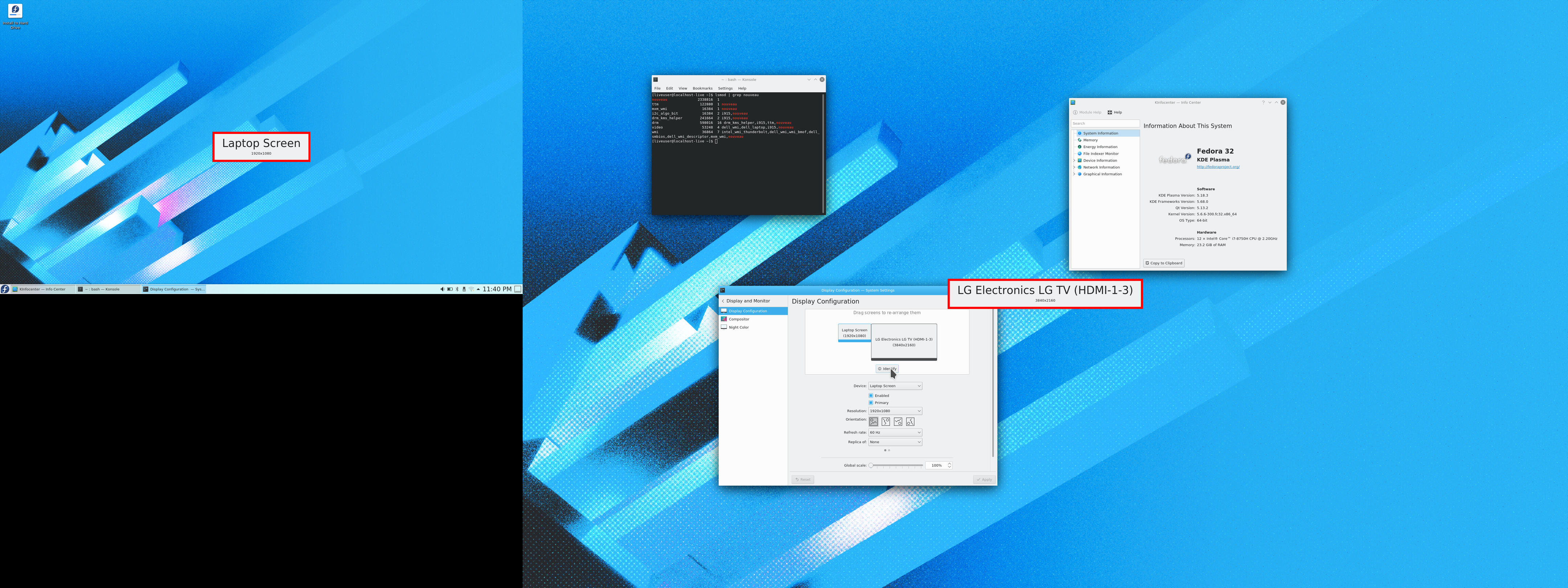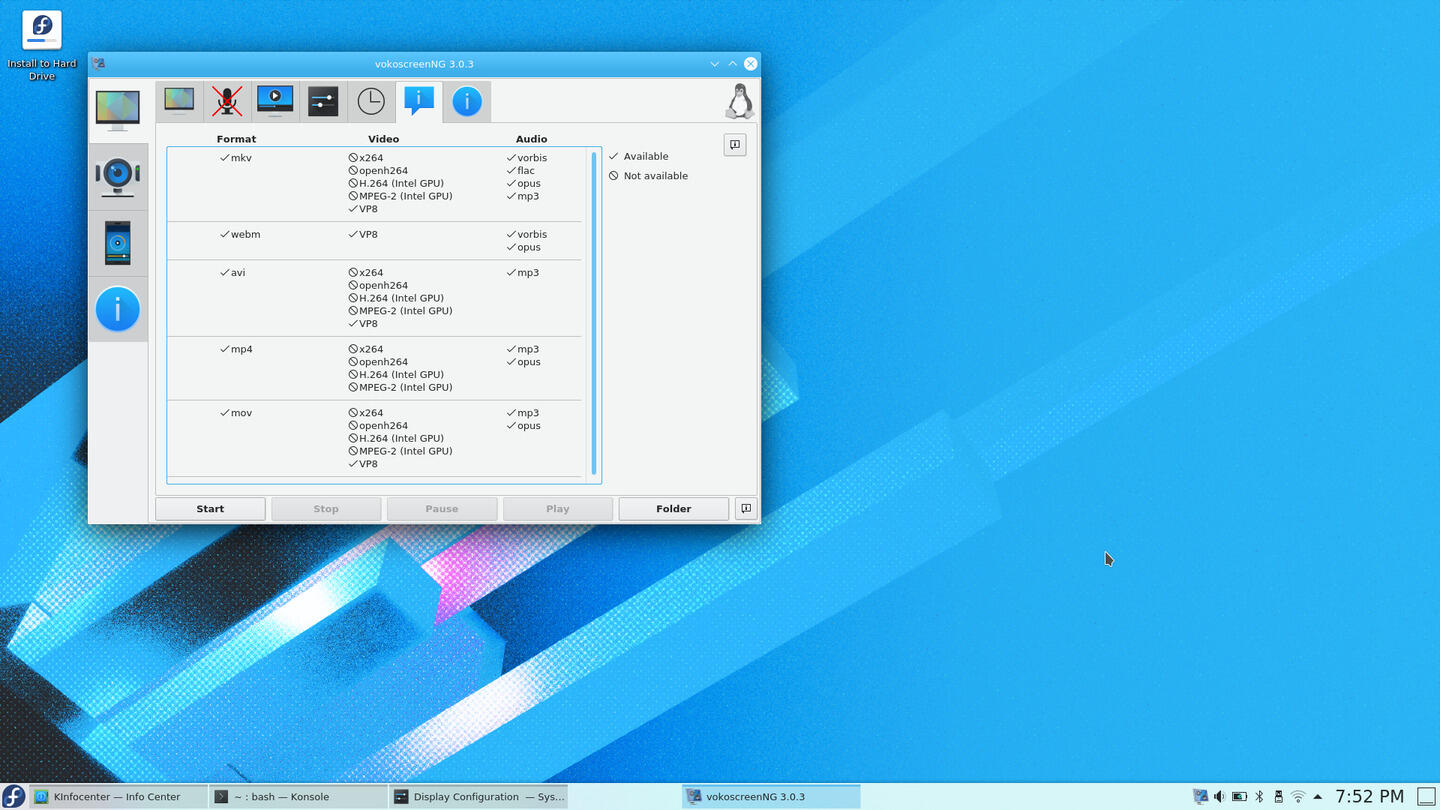Fedora 32 KDE Spin installation is largely straightforward and trouble free except for an issue with the installer window. Particularly impressive was that the Free and Open Source Nouveau driver used in the live environment was fully functional without the problems I have seen in the past on this laptop. Even an external monitor connected to the HDMI port did not have any problems, which is usually a problem because the port is connected to the Nvidia card.
This article, as a supplement to Fedora 32 Review [KDE Spin], describes (and shows) the installation experience.
Introduction
The Fedora installation experience like the pre-installation experience is one of the best. For users that find the Anaconda installer's partitioning module too complicated an additional partitioning tool is available called blivet-gui. And while it is nowhere near as powerful as the openSUSE installer, which allows complete customization of the installed system during the installation phase, including adding entries to /etc/fstab, the Fedora installer allows users to specify the userid and groupid of the created user during installation, an uncommon feature.
The only issues I faced were that:
-
Minimizing the installer application using the task manager applet in the panel (as the application window does not have a titlebar) results in a very small improperly rendered window. I had to restart the installer and only switched to other open application windows and refrained from altering the installer's window size. This was not an issue during my installation of Fedora 31 late last year, but at that time I did have to block the open source Nouveau to make the live environment usable. Maybe this difference is related to the issue.
-
The probing of other OSes on the system took an extremely long time, apparently an issue on all distributions, including during updates that require rebuilding the GRUB menu, except Arch and openSUSE.
-
The installer does not allow specifying a swap partition be included in the partitioning setup, as a result it is not included in the /etc/fstab of the installed system, requiring an edit in the installed system.
There was a big plus however in that the graphics setup in the live environment was excellent.
Live Environment
Booting the live ISO brings up a GRUB menu with two options, one for checking the installation medium image and starting the live environment; and another to just start the live environment. I selected the first without pressing e and editing the kernel command line options to include "nomodeset", something that has always been required when using many distributions' live environments on this Dell G5 with Optimus graphics consisting of an integrated Intel UHD630 and a discrete Nvidia GTX-1050 Ti graphics cards. To my surprise, there was none of the erratic behavior that typically occurs when on this laptop when the open source drivers are loaded on this laptop. I decided to plug in a recently acquired 43" 4K TV to the HDMI port to see what would happen. ( Before this external monitor I had always installed the proprietary graphics because of the problems with Nouveau and Bumblebee to keep the Nvidia card off and simply use the Intel card all the time. I recently learned that the HDMI port on the Dell G5 is internally wired to the Nvidia card which has forced me to install the Nvidia graphics without Bumblebee.)
I was pleasantly surprised when the external screen activated and the display expanded to the second screen.

An External Monitor Works Without any Problems Using Nouveau Despite the Problematic Hardware
Aside from this, there was nothing notable, either good or bad, in the live environment, except maybe the choice of software available in the live environment. While a full complement of software is available in the live environment, the Fedora KDE SIG which develops the KDE Spin has chosen to be very KDE centric in their selection of software, opting for including the Calligra office suite instead of LibreOffice. The Falcon Web Browser, a software application of the KDE project is included, in addition to Firefox.
As is the case in the installed system, some functionality is missing due to Fedora's strict adherence to its policy of only providing Free and Open Source Software. Because of this, Simple Screen Recorder, which I normally use to record installations from a live environment, was not available for installation into the live environment from the official repositories.

VokoScreen-NG Statistics Showing Missing Codecs
Instead I installed VokoScreen-NG which was available, but the version available from Fedora only includes open source codecs. (The lack of non FOSS software is easily correctable after installation thanks to RPMFusion.)
`
Installation
The video below shows the complete installation process I used. I had prepared partitions for the / and /home. Note the previously mentioned problem with the installer window at about 3:00. You may notice that after I restarted the installer, and confirmed my installation configuration the actual copying of software took very little time. The majority of time taken by the installation was the installation of GRUB and its probing of other partitions on the disks. I experienced the same behavior in the installation of Kubuntu 20.04 and have noticed it during updates of Manjaro which involve an update of GRUB taking twenty minutes for the GRUB update portion of the package update.
Some timestamps of the video:
- Restart installer 3:20
- Partitioning 6:13
- Confirm Installation Settings and Begin Copying of Files 9:47
- Configuring Storage 12:53
- Bootloader Installation Begins 12:55
- Default Software Overview 13:15
- Plasma Settings Display Settings Component 16:14
- GRUB Processes Displayed in top 20:17
- Directory Listing of /etc/X11 and /etc/X11/xorg.conf.d 20:45
- Default Dolphin File Browser 21:59
- Firefox Fedora Bookmarks and Release Notes and 22:35
- Bootloader Installation Ends 28:28
- Installation Complete 29:22
- Considered Editing fstab of Installed System Before Rebooting 30:28
Installing Fedora 32 KDE Spin
`
Conclusion
As usual, the actual installation experience was good, the Anaconda window issue notwithstanding. The Nouveau driver working out-of-the box is a new improvement in Fedora's live environment.